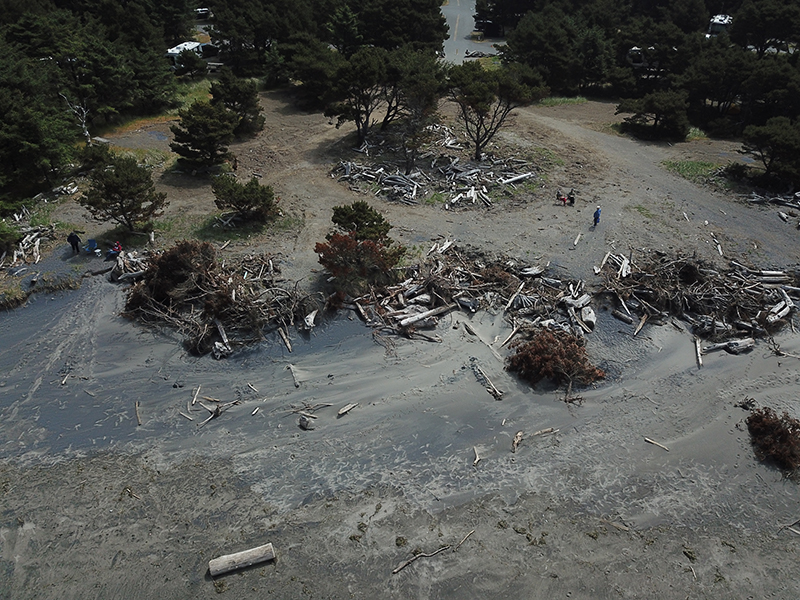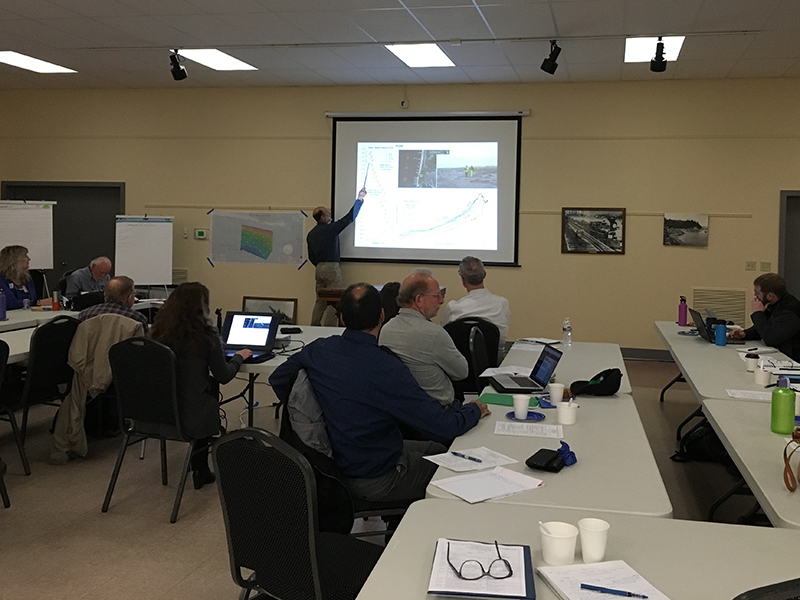
In September, the American Shore and Beach Preservation Association (ASBPA) awarded the Lower Columbia Solutions Group the 2020 Robert L. Wiegel Coastal Project of the Year. This award goes to coastal projects that have stood the test of time and shown a positive environmental, social, or recreational benefit.
With leadership from Ecology’s Coastal Management Program, the Lower Columbia Solutions Group (LCSG) spent almost 20 years working at the mouth of the Columbia River to reduce damaging erosion in the area by increasing the beneficial use of dredge sediment. This region is not only critically important to the ecology of the Pacific Northwest, but also one of the busiest hubs for maritime trade in all of North America.
The LCSG’s success in reimagining the planning process for the mouth of the Columbia River is being recognized as a model of collaborative science and decision-making. ASBPA Executive Director Derek Brockbank spoke recently with representatives from the U.S. Army Corps of Engineers, U.S. Environmental Protection Agency, and the states of Washington and Oregon as part of the "The Capital Beach” national podcast series.
A collaborative recipe for success
Members of the Lower Columbia Solutions Group watch a presentation about shoreline change analysis during an LCSG science-policy workshop.
The strength of the LCSG comes from its collective capacity. Its achievements are the result of strong relationship building, shared trust, and collective determination to sustain an important adaptive management process. In addition to Ecology’s steady role, leadership from the Corps’ Portland District, the Oregon Coastal Zone Management Program, EPA, and NOAA have provided the backbone to maintain the team as a national leader in dredging innovation. Collectively, the LCSG has been highly successful in advancing an emerging strategy known as thin-layer placement, which involves the use of dredged material to support multiple objectives, including the restoration and preservation of key coastal environments.
“One Ecology” and role of our Shorelands Program
Through what is called the “One Ecology” approach, different Ecology roles and responsibilities were optimized to provide more cohesive and comprehensive assistance to the LCSG.
The One Ecology team includes the Coastal Monitoring & Analysis Program, which plays a fundamental role in conducting scientific research and analysis to help understand sediment dynamics and effects of material placement activities.
Ecology's Section 401 team in Olympia and colleagues in the department's southwest regional office in Lacey conduct environmental reviews and provide permitting assistance to ensure state and federal regulations and policies are carried out on the ground.
Meanwhile, the our policy and planning team convenes the group, coordinates communication across multiple agencies and stakeholders, and ensures the development and implementation of the Regional Sediment Management Plan reflects the LCSG's goals and interests.
Importance of regional sediment management at mouth of Columbia River
The Columbia River provides a crucial link between ocean and inland waters for endangered salmon and other species, while the river mouth is home to one of the United States’ largest Dungeness crab fisheries. Economically, the Lower Columbia is one of the nation’s major shipping corridors, responsible for transporting over 50 billion tons of cargo annually. It is the third largest grain export gateway in the world.
In order to keep the Columbia River shipping channels open, the U.S. Army Corps of Engineers-Portland District dredges about 3-5 million cubic yards of sand from the river’s mouth annually. The dredged material is primarily clean quartz sand, but prior to LCSG’s formation, about one-third of the sand was taken to a designated deep water disposal site. This resulted in the removal of a large portion of clean, uncontaminated sediment, where it otherwise would be expected to help sustain jetties, beaches, and marine habitat.
At the same time, the highly-engineered entrance to the Columbia River, combined with upriver dams and other structures, has altered the river’s flow and reduced the historic level of sediments moving through the river mouth by nearly two-thirds. With less sand to buffer wave energy, increasing rates of erosion jeopardized nearby ocean beaches, jetties, and sandy bottom Dungeness crab habitats.
Two decades of partnership
Recognizing that the worsening erosion situation called for ambitious, comprehensive, and coordinated action, the governors of Washington and Oregon first convened the LCSG in 2002 to work toward a solution. The LCSG is a diverse, bi-state partnership of local, state, and federal agencies, fishing and crabbing interests, environmental groups, developers, and other stakeholders. Ecology’s Coastal Management Program, located within the Shorelines and Environmental Assistance Program, has provided leadership on LCSG efforts from the beginning. For more details, see the LCSG video "Building Consensus Through Collaborative Adaptive Management" in the lower Columbia River estuary.
During the past 20 years, the LCSG has developed and refined dredge disposal techniques to reduce discards and increase the beneficial use of dredged material to 85% by 2019. At the same time, the group has used innovative monitoring and analysis to ensure that the material does not adversely affect the safety of fishing and shipping fleets or compromise the health of local fisheries and the surrounding environment.
Check out an educational video on how scientists investigate the effects of sediment deposition events on benthic communities: https://lowercolumbiasolutions.org/research-videos/



